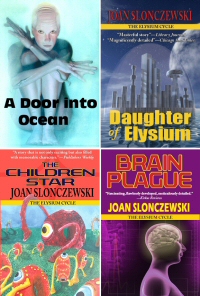The Iroquois kidnapped new genes
In Octavia Butler’s Dawn (Lilith’s Brood), an advanced star-faring species engineers itself to such “perfection” that it must kidnap other beings (including humans) to obtain their “imperfect” genes. Would humans ever do such a thing?
Before colonization, the native American population (who actually traveled the farthest from Africa) were the least diverse genetically, the most “clonal” continental group. Their low diversity, especially in immune genes, partly explains why the natives fell so rapidly to smallpox and other introduced diseases. Interestingly, some addressed the problem as Butler’s species did: They kidnapped “outsiders.”
The most adept at adoptive diversity were the Iroquois. When an Iroquois community lost too many members to disease, they raided their neighbors (other tribes, or else Europeans) for captives to “replace” their lost siblings and children. The raids were no picnic; but then, European colonial life was so wretched (try being an indentured servant) that some colonists joined the Iroquois voluntarily. Adoptees were quickly married off, thus contributing their disease-resistant genes.
Where else have we sought adoptive diversity? Either amongst humans, or in breeding our animals and plants?
Trackbacks
- Today’s Shared Links for October 21, 2011 @ Chuqui 3.0
- DYSPEPSIA GENERATION » Blog Archive » The Iroquois Kidnapped New Genes
- Kidnapping tribal children « Ultraphyte
Comments are closed.


Sadly, we’re bad at creating genetic diversity in our companions and crops. Dead dalmations, cloned bananas… the list is nearly endless.
Which makes we want to say: Adopt a mutt (although they’ll be healthier, shelter dogs are usually neutered, meaning that you can’t pass on that hybrid vigor), and eat a more varied cuisine.
whoops — _deaf_ dalmations.
Absol-fragging-lutely. “Shelter mutts” are also more loving, loyal and intelligent than more or less anything else you’ll find except the various collie breeds.
Isn’t that like Octavia’s Oankali–engineered themselves to obsolete “perfection”?
In crop plants, when we breed a species too clonal, we have to find a wild species that’s resistant, then breed it into the “pure” strain (essentially what the Oankali did.)
That is the old approach; still needed. The new approach is to search the genome for a gene to change, but that’s looking for a needle in a haystack. That’s what they’re trying to do for bananas.
The WSJ had an article about this very subject on Saturday: Monsanto, long-vilified for their genetic engineering (sigh) is now working on breeding techniques to get desirable genes into vegetable plants, finding distant cousins to cross-breed, and DNA techniques to verify the results but not insert genes. It’s like working with one hand behind your back, but if it improves crops and people will actually eat them, it’s a good thing, versus silly boycots (e.g. McDonalds’ refusal to buy GM potatoes killed a Colorado Beetle-resistant variety)
Well, the obvious case would be the increase in so-called mixed race couples and children. I mean, here we were heading towards geographically isolated subspecies (yes, I think so, had we remained a bit more sedentary), and instead you’ve almost every possible combination and permutation now (the great African diaspora to the New World, the Thai colony in Spitzbergen above the Arctic Circle, Hmong in Minneapolis mating with Scandinavian stock, to name just three examples).
And what about breeding with Neanderthals. What’s the status on that? Do we or don’t we have Neanderthal genes?
Seems that humans will attempt to mate with just about anything that will stand still long enough. I’m surprised we all don’t look the same at this point, but give it another century or two, if energy stays cheap and travel is easy.
Um, speaking as someone in a so-called mixed race relationship, it’s….interesting to read a statement like this. I’m trying to figure out whether I was the one standing still long enough, or whether my partner was.
I’d also point out that my ancestors go back to something like the 17th Century in the US, and every few generations, someone married a recent immigrant. This is pretty much the definition of being a citizen of the New World, whether you’re classified as American, Hispanic, African-American, or all three. Moreover, it’s certainly been happening since Hernan Cortes took an Aztec princess as a concubine and had children with her.
Finally, I’d point out that, given the diversity of people labelled “Hispanic” or “American” right now, after 500 years of intermingling, I seriously doubt we’re all going to look the same any time soon.
“In crop plants, when we breed a species too clonal, we have to find a wild
species that’s resistant, then breed it into the “pure” strain”
Your post & comment reminded me of how, once a line is too inbred, dog breeders
will find a similar (related?) breed to bring into their line, and over the
following generations select to bring it back to the AKC standard. Not that that is necessarily a good thing.
Had to make sure I had that right, so looked it up:
http://en.wikipedia.org/wiki/Purebred#True_breeding
I guess I read the Oankali differently: they called themselves gene traders, and human cancer was supposed to be some sort of new ability they wanted to grow limbs faster, or some such.
The Iroquois weren’t the only people to adopt outsiders into groups, or to breed with outsiders. It crops up all over the place, and is still a standing joke when talking about why people become foreign exchange students–or date them.
Breeders involved in the Backcross project have used outbreeding to improve the health of Dalmatians. Some breeders, unfortunately, take a dim view of certain types of exogamous breeding practices.
Genetic analysis of Icelanders suggests that Vikings picked up women from the British Isles before settling in Iceland.
Your comment reminds me of the British Royal family, who selected a princess of African descent for King George III (Queen Charlotte). According to one historian I heard, the German-African princess was selected because her people were known for “bearing down” during labor and would thus likely produce heirs. She did indeed produce 15 children.
I hadn’t heard the “African Queen” theory. However, if you look at her ancestry, any claim of “African” descent is pretty remote. The best that can be argued is that she’s a 15th descent from some Vandals who moved into Northern Africa.
From what I’ve heard (from a friend of my father who worked there) the Inuits on Greenland have a longstanding tradition for faraway guests to bed their wives when they are visiting.
It is considered very rude to decline, to the point of it not being an option.
Seems like a very pragmatic way to get new genes into isolated communities 😉